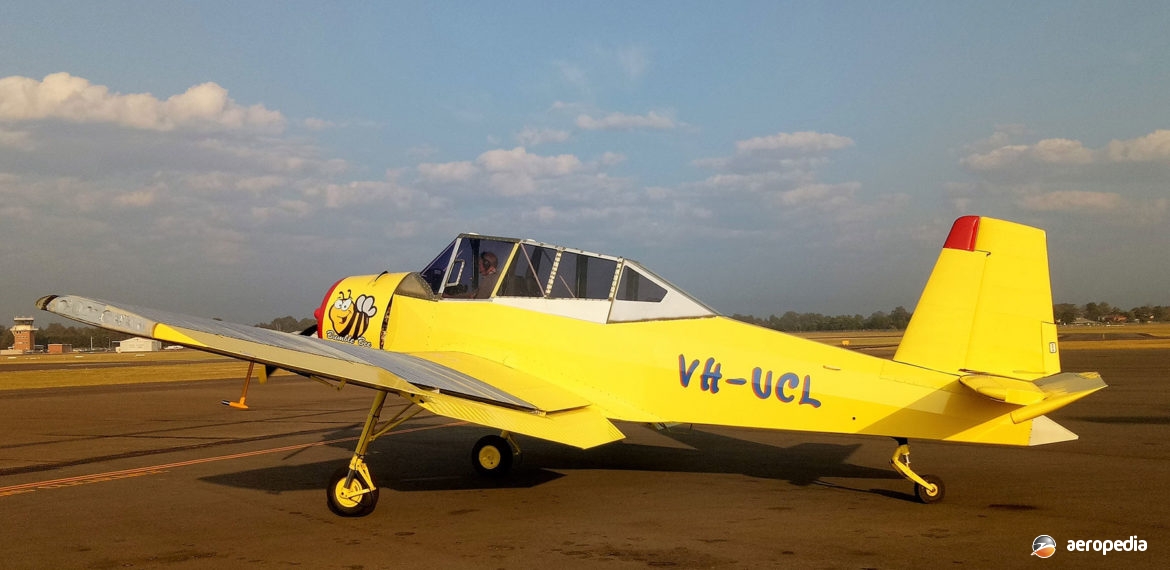Photograph:
Let Z-37 Cmelak VH-UCL (c/n 163) , known as the JZD-37, at Bankstown, NSW (Josef Melvaid)
Country of origin:
Czechoslovakia
Description:
Single-seat agricultural monoplane
Power Plant:
One 235 kw (315 hp) Walter M 462 RF nine-cylinder supercharged radial air-cooled engine
Specifications:
- [Z-37A-2]
- Wingspan: 12.22 m (40 ft 1¼ in)
- Length: 8.55 m (28 ft 0½ in)
- Height: 2.9 m (9 ft 6 in)
- Wing area: 23.80 m² (256.18 sq ft)
- Never exceed speed: 210 km/h (130 mph)
- Cruising speed at 75% power: 183 km/h (114 mph)
- Cruising speed at 65% power: 160 km/h (99 mph)
- Stalling speed, clean: 90 km/h (56 mph)
- Stalling speed with 15 degrees flap: 81 km/h (50 mph)
- Normal operating speed in agricultural role at sea level: 109 km/h (68 mph)
- Endurance: 5 hours
- Range: 640 km (398 miles)
- Rate of climb: 282 m/min(925 ft/min)
- Service ceiling: 4,000 m (13,125 ft)
- Take-off run no load: 50 m (170 ft)
- Landing run: 100 m (328 ft)
- Fuel capacity: 250 litres (55 Imp gals)
- Empty weight: 1,043 kg (2,299 lb)
- Useful load: 807 kg (1,779 lb)
- Loaded weight: 1,850 kg (4,078 lb)
History:
The Z-37 Cmelak (Bumble Bee) was designed and built by LET Narodni Podnik, the LET National Corporation, which evolved from a branch of the Skoda series of companies. The prototype, the XZ-37, fitted with a 231 kw (310 hp) Ivchenko AI-14VF nine-cylinder radial engine, was flown for the first time on 29 March 1963. It was designed primarily for agricultural duties but one of its features was its extreme versatility in a number of roles. Primarily aimed at the single-seat crop-spraying market, it could be fitted with a second seat for a mechanic, and pumps and other associated equipment could be removed from aft of the cockpit so the aircraft could be used as a light freighter. Simplicity of design was also important, so it could be operated under primitive conditions with little or no maintenance facilities.
Ten prototypes in all were built, all fitted with the Ivchenko AI-14VF engine but production machines received the Walter M-462RF engine. Certification was received on 20 June 1966 and it was used in a number of roles, basically as a crop-duster, but also as a mail and cargo transport or glider tug. It regularly operated on skis as well as wheels. An improved and strengthened variant was the Z-37A-2, developed in 1974, a total of 739 examples being built, production concluding in 1984. It was very popular in Eastern Europe, some operators claiming 4,000 hours before engine overhaul.
A development released in 1981 was the Z-37T Agro Turbo, later re-designated the Z-137A, which was the basic Cmelak with an extended fuselage, an extended fin, winglets and a 362 kw (485 shp) Walter M-601 turboprop. Some 50 examples of this model were completed, a number of these being imported to New Zealand for operation in the agricultural role. The type in Europe regularly towed two gliders, and had been known to tow four for a cross-country transit flight. Examples are privately owned in the United Kingdom and the United States.
An example of the Z-37 was imported to Australia in about 2008 for operation as a private aircraft in the experimental category. It underwent a complete rebuild at Bankstown, NSW, taking about 11 years. This aircraft was a Z-37A-2 with the construction number 16-18, which commenced life in Hungary with the registration HA-MGR. It later operated as OK-CJJ in Czechoslovakia and as OM-CJJ, before being retired and imported to Australia.
In Australia it became known as a JZD-37 on the civil register and became VH-UCL4 (c/n 163) to its owner / builder, Josef Melvaid, of Kogarah, NSW. It was registered on 1 February 2016. He used parts from the original Z-37A-2, fabricated some parts, and fitted it with a Walter M 462 RF radial engine driving an Avia V520 propeller. It has a useful load of 800 kg (1,700 lb) and, like a few similar aircraft conversions overseas, has seating for four in the cockpit with leather upholstery. It is covered in Roly fibre with a Ranthane top coat. In late 2017 it was noted for sale and in early 2018 was based at the skydiving airstrip at Wilton, NSW.

